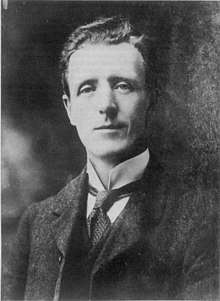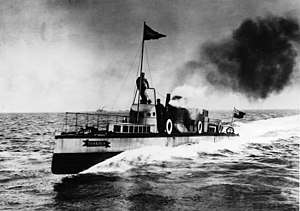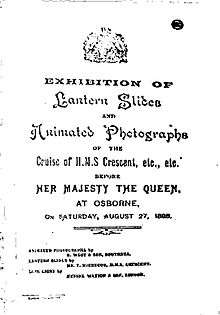Alfred John West
Alfred John West (1857–1937) was a British award-winning marine photographer in the Gosport firm of G. West and Sons from 1881 (for an early reference see Exhibition Catalogue of the Photographic Society of Great Britain) and from 1897 at the age of 40, a pioneer cinematographer. He was then active in both roles until 1913 when he sold his copyright in negative plates of yachting studies to Beken of Cowes, and his stock of positive moving film in 1916 to a distributor, James Joseph Bennell, proprietor of: B. B. FILM HIRING SERVICE, 81, Dunlop Street, in Glasgow (see 'The Bioscope' - Thursday 07 September 1916 https://www.britishnewspaperarchive.co.uk/titles/the-bioscope) On the closure of the business, the film stock was then sold onwards to the 'Argosy Film Co. Ltd' in 1917 a company also registered at 81 Dunlop Street on 2 August 1917 (See 'The Bioscope' - Thursday 20 September 1917 page 6) which was in film business through the 1920's but was liquidated in 1930, the business passing to 'Audible Filmcraft' which was itself wound up in 1931. It is believed that the positive film stock was transferred from West to B.B. Hiring without completing the purchase.

West confirms in his unpublished autobiography 'Sea Salts and Celluloid' (1936) that he sold the film hire business to a Glasgow distributor to be paid for over several years but that he '... kept the negatives' . However he was never paid and the bulk of the film stock cannot now be traced. A few tantalising clips remain as does a full descriptive catalogue in the British Library of all the moving film he created under the 'Our Navy' brand. Some potential clips have been located in the British Film Institute's online collection and those found so far are listed on the Our Navy website. The stock of AJ West's negative plates was sold to Beken of Cowes in 1913 and is now (2020) being prepared for sale as a complete archive of yachting prints by the Brett Gallery Midhurst Hampshire. West's plates are said to be numbered from 500 to 10250 in the Beken/Brett archive. Alfred West died in 1937 and is buried at Highland Road Cemetery Portsmouth in Hampshire (E Plot, Row 19, Grave 14).
Business
From c. 1880 Alfred John West worked alongside his brothers and sisters in his father George West's photographic business 'G West and Son' at 97 High Street in Gosport Hants and later at 72 and 84 Palmerston Road Southsea. He became a nationally and internationally famous marine photographer, winning many national and international medals for his studies of yachts in full sail. His portrait of the 'Mohawk' winning at the Royal Southampton Yacht Club Regatta in 1888 was awarded the gold medal at the St. Louis Convention USA for which 9 other countries competed.
In 1897 he converted to the newly developed 'moving' film and by 1898, his personal cinematographic business 'Our Navy' based in an annexe called 'The Anchorage' at his home 'Rozel' 7 Villiers Road Southsea, had a full-time staff of 50. In 1902 he formally registered the name 'Our Navy' under Limited Company number 72532 (National Archives Kew – Piece details BT 31/9737/72532).
Alfred West's cinematographic activity from 1897 was in exhibiting films related to Naval, and later Military, Empire and Yachting subjects under the general title of 'Our Navy'. The shows were presented in halls and later in purpose-built cinemas across the UK and the British Empire.
The London home of 'Our Navy' was the Regent Street Polytechnic (now the University of Westminster), which still houses one of London's first purpose-built cinema halls, the Regent Street Cinema. The Lumiere Brothers gave the first ever public film show of moving pictures in the United Kingdom on 21 February 1896 in the hall. (A programme of restoration has been carried out which has revived the cinema and revealed a few of its late 19th Century features). 'Our Navy' also exhibited at The Crystal Palace and the People's Palace in the Mile End Road.
Photographic methods
Alfred J West invented his own shutter and stabilising devices and mounted his heavy dry plate camera in the well of a sailing yawl. This was manoeuvred by his boatman under the lee of large racing yachts to obtain the best shots of these heavily-canvassed vessels at full speed.
In 1898, during the early period of Cinematographic technical development, his employee James Adams was granted a patent for "Improvements in and relating to cameras and projecting Apparatus for Kinematograph Pictures" (No. 9738 of AD 1898) by the UK Patent Office.
Photographing the Turbinia

In 1897, Alfred J West obtained photographs of the Turbinia steam yacht travelling at full speed at the Royal Fleet Review. He was subsequently invited by Charles Algernon Parsons to film and photograph the vessel in the Tyne and the pictures captured remain the defining image of Turbinia at speed. Sir Charles Parsons is believed to the person standing in the conning tower in this picture. None of the moving pictures have survived.
West writes in his (unpublished) 1936 autobiography as follows:
- "It was at this same Review that a wonderful little vessel named the Turbinia appeared, steaming through the Fleet at 35 knots, a speed never before achieved on water. She was the first ship to be fitted with the turbine machinery invented by her owner, the Hon. C. A. Parsons of Newcastle-on-Tyne, and a great sensation was caused by her steaming through the lines at such a speed. Whilst she was at anchor in Portsmouth Harbour, I went aboard and told the owner that I would like to get a snap of his craft going at full speed. "No one has succeeded yet, although many have tried", replied Mr. Parsons. "I should like to have a shot at her", I persisted. "Alright, so you shall!" he said with a smile, "I will make another run through the fleet tomorrow, look out for me between lines A. and B. at noon. That should give you an opportunity. "I'll be there, opposite the Flagship", I told him. Punctually at l2 o'clock there appeared between the leaders of the lines a smother of foam – it was the Turbinia. As she raced past the Flagship, I was waiting in my launch and took a flying shot of her. When I developed the plate I was delighted to find that I had "got her", and the owner was so pleased with the result that he invited me to take a number of photographs and a cinematograph film of his craft on the Tyne."
Subsequently, West's 'Our Navy' made regular use of this shot in its publicity and brochures, and the moving pictures of the vessel were frequently shown as part of the performances and referred to specifically in the promotional material associated with the shows as ' Turbinia ... showing the effects of foam etc '.
Royal Command Performances – 1898 and 1901

In 1898, Alfred J West embarked with his staff member Chief Petty Office Thomas McGregor as ship's photographer and cinematographer on the three-month cruise of HMS Crescent, commanded by The Duke of York (later George V). On its return to port, he gave a Royal Command Performance of the material to Queen Victoria at Osborne House in the isle of Wight. The Duke of York wrote a short review of the performance in his diary for 27 August 1898 "After dinner West showed his animated photographs & McGregor the photos he took on bd. The 'Crescent' on a screen, very well done" (Diary Extract reproduced by kind permission of HM The Queen)
A second Royal Command performance showing 'animated photographs' was given to Edward VII, his family and Estate staff on 9 November 1901 at Sandringham. The film shown at that presentation was taken by Alfred West's assistant, Chief Petty Officer McGregor, who had been taken on board as official photographer for 'Our Navy' for the world cruise of the converted liner 'Ophir'. The cruise was undertaken by The Prince of Wales (later George V) and his family. Although West wrote proudly in his unpublished autobiography that the event was successful and involved ministers of state and other guests, the Prince of Wales wrote about this occasion on 10 November 1901 saying: "Afterwards West and McGregor showed the cinematograph photographs, taken by the latter, during our tour in the Colonies in the ball room, all the tenants & servants came, they were interesting but not very successful." (Diary Extract reproduced by kind permission of HM The Queen).
Trafalgar centenary 1905
At the culminating Albert Hall celebrations on 21 October 1905, Alfred West showed a programme of patriotic and nautical films. The Times of London reported on 20 October: "... Mr Alfred West, well known for admirable kinematographic shows of a naval character, will give a novel one, illustrating the reception of the French Fleet". The show also featured a sequence of a very old seaman who had served with Admiral Hyde-Parker (one of Nelson's captains) accompanied by a petty officer from the Royal Naval Barracks and two boys from the Royal Seamen and Marines’ Orphanage. The action took place on the quarterdeck of HMS Victory, the elderly seaman showing a young boy the features of the ship – the ship's wheel, the memorial plaque 'Here Nelson Fell' and culminating in the laying of a wreath. This short sequence survives as one of the extant film clips of 'Our Navy'.
Ephemera collections
Much work was done by the late twin brothers John and William Barnes, film historians, in tracking down and collecting ephemera related to Alfred West, 'Our Navy' and the G. West and Son precursor business. This is held for posterity in the Barnes Collection at Hove Museum and Art Gallery. Some material not yet deposited and catalogued is held privately.
Books of press cuttings collected from South Coast newspaper libraries by West's grandson, Antony Scott Clover (1917–1998), are held in the family, as are some facsimile copies of ephemeral material and prints of yachting plates.
A series of cigarette cards and postcards in a numbered series were produced to accompany the 'Our Navy' presentations and these were widely circulated and are still collected by specialists.
'Spot' promotional material included slips of paper promoting the show which were enclosed in a blue wrapper to give the appearance of medical 'powders' often taken for headache and other ailments. Hundreds of these were placed in public places awaiting discovery.
Extant film clips
The few clips that are still extant of West's film are held as originals in the BFI National Archive and are curated by the Wessex Film and Sound Archive at Winchester, Hants.
They can also be viewed in low resolution on the 'Our Navy' Website
The following titles are listed (amongst others) at the Internet Movie Database. It is not yet known who has compiled the list or from what source, but the titles listed are convincing:
- The Bombardment of Port Arthur 1904
- Attack and Defence by Sailors 1898
- Away Aloft: Climbing the Rigging on Board the St. Vincent 1898
- Away Boats' Crews 1898
- Barbette Guns in Action 1898
- Boats of the Channel Squadron Pulling Round the Fleet 1898
- Commander Giving Instructions: Beat to Quarters 1898
- Commander Giving Instructions: Dismiss 1898
- H.M.S. Crescent Leaving Portsmouth Harbour 1898
- H.M.S. Crescent Steaming at Full Speed 1898
- Lee Bow View of Crack Yachts 1898
- March Past on the Quarterdeck 1898
- Midshipmen at Physical Drill 1898
- Naval Brigade Firing Royal Salute on Southsea Common 1898
- On Board H.M.S. Majestic: All Hands on Deck 1898
- One Design Yacht Gybing Round Outer Spit Buoy 1898
- Portsmouth Dockyard Gates 1898
- Seamen at Drill: Sailors at Field Gun Drill 1898
- Seamen at Drill: Sailors at Single Stick Exercises 1898
- The Channel Squadron Getting Under Way 1898
- Torpedo Practice 1898
- Turbinia 1898
- Two Best Dancers in the Navy Dancing on the Forecastle 1898
- Weather View of Yacht Racing in Rough Sea 1898
These entries may relate to extant clips preserved from the period, or they may simply have been copied from a contemporary catalogue.
References
- Pioneers of the British Film, John Barnes, Bishopsgate Press, 1983 ISBN 1-85219-012-4, pp. 45–53
- Who’s Who of Victorian Cinema, Stephen Herbert and Luke McKernan (eds), British Film Institute, 1996, ISBN 0-85170-539-1, pp. 149–150
- Alfred John West and the Trafalgar Centenary, David Clover, H. Lewis-Jones, A. Cross (eds), The Trafalgar Chronicle 2009, ISBN 978-1-902392-19-6, Vol 19, pp. 266–282
- 'Limelights and shadows' : popular and visual culture in South West England, 1880–1914, Leveridge, Rosalind Claire, PhD thesis, pp192–195, University of Exeter, 2011

External links
- 'Our Navy' main website
- Extant Film Clips
- IMDB Entry
- 'Sea Salts and Celluloid' – West's Autobiography
- Facsimile of film catalogue
- Transcript of film catalogue
- AJ West's Obituary – Hampshire Telegraph and Post
- Who's Who of Victorian Cinema
- Beken of Cowes
- Brett Gallery Midhurst
- Wessex Film and Sound Archive
- Barnes Collection Archive – Hove Museum
- Charles Urban Motion Picture Pioneer
- Regent Street Polytechnic Cinema Project